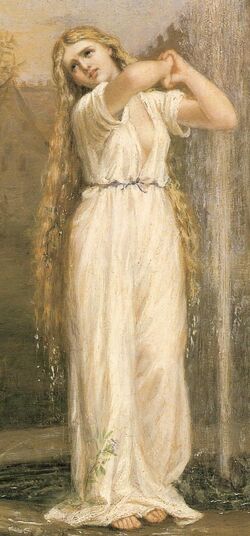| Undine | |||
|---|---|---|---|

| |||
| Naming | |||
| Others | Ondine Nymph | ||
| Binomen | N/A | ||
| Morphology | |||
| Body type | Humanoid | ||
| Intelligence | |||
| Sentience | Sentient | ||
| Sapience | Sapient | ||
| Aggressivity | Varied | ||
| Ecology | |||
| Habitat | Water | ||
| Subspecies | Mermaid Nereid Naiad Oceanid | ||
| Behind the Scenes | |||
| Universe | Real | ||
Undines (a.k.a. Ondines) are a race of humanoid water-elementals first described by the 16th century alchemist Paracelsus as one of the four elemental races - the other three being Gnomes (earth), Sylphs (air) and Salamanders (fire). He and other scholars also referred to them as Nymphs.
Traditionally, they're described as being about the same size of a human being (unlike Gnomes which are much shorter) but may also be depicted as smaller, or as able to change their size. They're far more commonly depicted as female, with males being extraordinarily rare. They may be associated with any kind of water bodies such as rivers, lakes, ponds and waterfalls, not to mention the seas and oceans.
Biology[]
According to Paracelsus, the elementals are material creatures, not unlike human beings, which need to eat and sleep. They're not made of the same corporeal substances as we are, but they're still not considered spirits either. Instead, they occupy an intermediate position between these two categories of beings: both spiritual and corporeal.
Each elemental is able to move through and survive within their own element, but not in others. As such, Gnomes move through, see through, breath and live within earth and solid rocks. The same applies to Undines in water and Salamanders in fire. And the Sylphs are the most human-like of the four because like humans, they live in, see through, breath and move through air.
The factor that distinguishes humans and elementals is that the human being is made of a body, a spirit, and an immortal soul. The elementals have the body and the spirit but lack the soul, meaning that they cease to exist upon death. They may acquire a soul, however, if they marry a human being.
In popular culture[]
The notion that an Undine has no soul, but may gain one if she marries a human has become the basis to Friedrich de la Motte Fouqué's 1811 fairy tale novel Undine, which has also been adapted as an opera by Fouqué himself and E. T. A. Hoffmann. The same notion is applied to Mermaids in Hans Christian Andersen's equally influential fairy tale The Little Mermaid.


